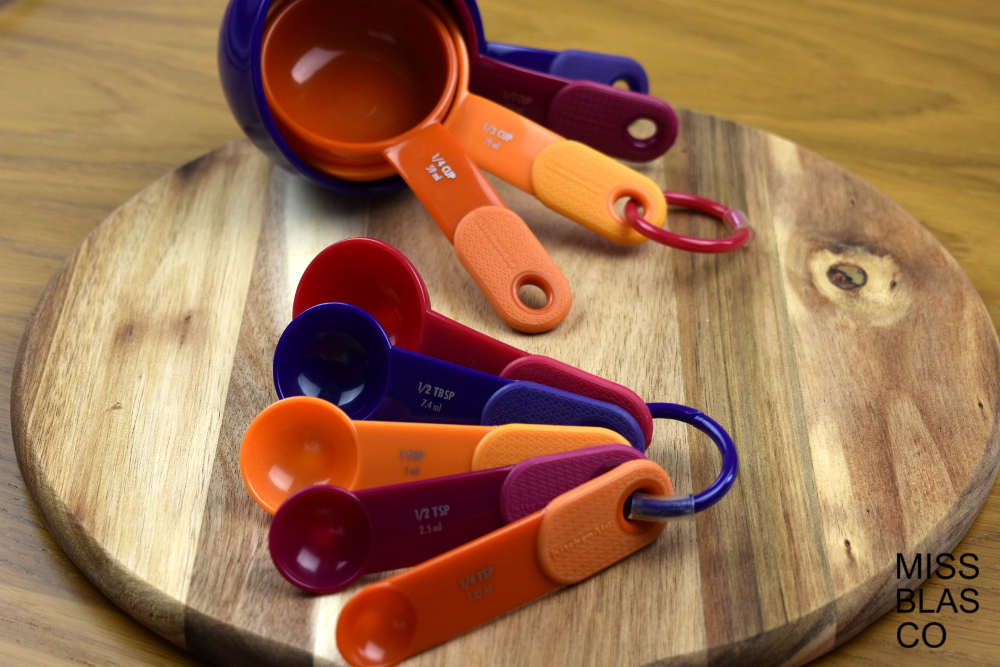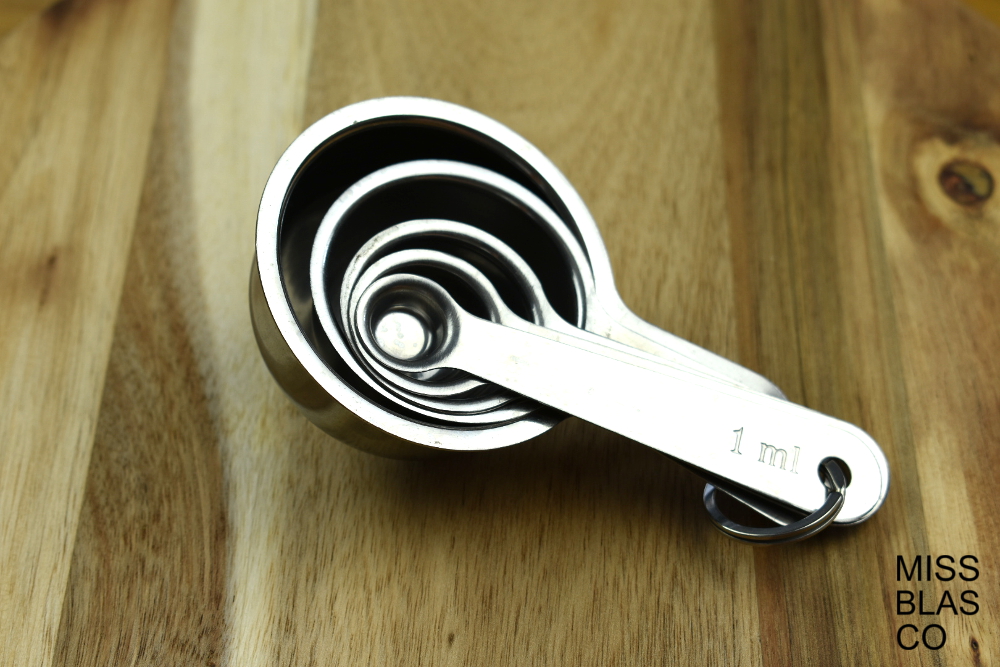
MEASURING SPOONS AND CUPS
Cups, spoons, teaspoons… It’s definitely time to clarify what kind of measurements I usually use in the kitchen. Many of my blog readers have asked me about it and you deserve an explanation.
Spoons and cups are the reference measurements in England and the United States.
To begin with, I want to tell you that when I started cooking, being very inexperienced, I used to prepare recipes by eye, or with improvised homemade measurements, like “one glass” or “one cup”, leaving the question of what type of glass or what type of cup in the background.
You can imagine how well everything turned out for me, but little by little I learned to organize myself and prepare the ingredients I needed for a specific recipe in advance. I’m self-taught at this, so it took me a while.
At first, I got a measuring cup and a scale. These two objects allowed me to measure by volume and weight respectively, and they were undoubtedly a great improvement.
I wrote down the quantities of everything I used to prepare each dish, I started to create my recipe archive, and one day, just by chance, I discovered Anglo-Saxon measurements.
In Spain, we work by weighing ingredients, especially in baking. Switch to measuring spoons, convenience guaranteed.
I had been reading American cooking blogs and websites for some time, and some English ones too. At first, every time I read “cup,” I thought… “cup,” but as I was telling you before, I didn’t notice what type of cup it was, I read “tablespoon” and thought… “tablespoon”, but I didn’t know if it was a soup spoon, a dessert spoon, or a coffee spoon.
After a while I realized that all of that didn’t make sense and I started to investigate, and I quickly realized that it was a measurement system that was used in baking and many other recipes throughout the English-speaking world. I saw how convenient it was and I knew I couldn’t continue cooking without them.

I had to get a set of measuring cups and spoons, back then they weren’t easily available in Spain, at least not in my area (I’m sure they were in specialty stores in big cities), so I waited until my next trip to the US and bought them, they’re very common both there and in England.
If I hadn’t traveled, the easiest thing would have been to buy them online. Nowadays in Spain you can find them in the kitchenware section of many stores and they don’t involve a large outlay.
Measuring spoons allow you to cook with precision without the need for a scale or other instruments complex.
Today I have several sets of measuring cups and spoons, I have bought them on different trips and I even bought a set at Ikea, they are stainless steel spoons and cups whose capacities are not exactly the same, they are adapted to the European decimal metric system, but they perform the same function.
You may find all of this interesting, but you may still experience some confusion, to clarify things, you can see the volume equivalencies below for liquid ingredients.
Spoons (Tbsp) and teaspoons (Tsp):
| 1/4 Tsp | 1.25 ml |
| 1/2 Tsp | 2.50 ml |
| 1 Tsp | 5 ml |
| 1/2 Tbsp | 7.4 ml |
| 1 Tbsp | 15 ml |
Mugs (Cups):
| 1/4 taza | 59 ml |
| 1/3 taza | 79 ml |
| 1/2 taza | 118 ml |
| 1 taza | 236 ml |
No es fácil traducir recetas cuyos ingredientes se especifican por peso, ya que el mismo volumen para diferentes productos tiene distinto peso.
Si queremos conocer las equivalencias en gramos, la cosa se complica, ya que, por poner un ejemplo, el mismo volumen de harina de trigo y de almendra molida no pesa igual. Es decir, 1 Tbsp de harina de trigo no pesa igual que 1 Tbsp de almendra molida.
Ese es el motivo por el cual es difícil traducir una receta que está diseñada con las medias en gramos a tazas y cucharadas.
Cuando empieces a familiarizarte con las tazas y cucharas, te darás cuenta de la comodidad que supone su uso, y no querrás volver a pesar nada, te lo aseguro.
También es interesante conocer las equivalencias entre las tazas y las cucharas/cucharaditas, es decir, a cuántas cucharadas equivale 1 taza, 1/2 taza, etc. Para eso he preparado una sencilla tabla que puedes ver a continuación:
Equivalencia entre Tazas, cucharadas y cucharaditas. |
||
| TAZAS (CUPS) | CUCHARADAS (TBSP) | CUCHARADITAS (TSP) |
| 1/4 TAZA | 4 | 12 |
| 1/3 TAZA | 5 | 16 |
| 1/2 TAZA | 8 | 24 |
| 3/4 TAZA | 12 | 36 |
| 1 TAZA | 16 | 48 |
Cucharas medidoras y tazas las hay de muchos tipos, a mi me encantan las de acero inoxidable, es un material que no se estropea y te dura para siempre, pero las de plástico son también muy prácticas.
Las que no te recomiendo usar a diario son las de otros materiales menos indicados para alimentos, un ejemplo de ello son las que puedes ver en la imagen de la portada, que son decorativas, quedan muy bien en las fotos, pero no son para todo uso.

Quizás te extrañe un poco lo de medir los ingredientes así, pero si te paras a pensar, hay algunas recetas en las repostería española cuyas medidas se basan en un recipispecific entity, I’m sure you already know what I’m talking about, the classic yogurt cake, it sounds familiar to you, right?
At home it was prepared from time to time, and it consisted of preparing a basic sponge cake with yogurt, whose container, which has a capacity of approximately 125 ml, was used to measure the rest of the ingredients, the flour, sugar and oil.
Another dough that I remember seeing my grandmother make, whose measuring instrument was a glass of water (250ml), was a dough for a pie, it involved mixing a glass of beer and another of oil, and then adding flour little by little until obtaining a manageable dough that could be spread out.
These are just two examples of how measurement by volume has always been done. One of the gadgets that is never missing in Spanish kitchens is a measuring cup with its hundreds of marks for liquid and dry ingredients.
With measuring cups and spoons you can forget about it, recipes that are measured based on cups and tablespoons are easy to execute, intuitive and easier to remember.
Measuring spoons will mean a before and after in your homemade recipes.
Advantages of measuring spoons and cups:
- Regularity in your results, your recipes will always turn out just as good.
- You don’t need a scale.
- It’s more easy to memorize recipes.
- They come in many sizes, some spoon sets measure up to 1/8 tsp, (1/8 teaspoon, would be “a pinch”).
- When we use condiments and spices it is very easy to adjust the dose, and the result is always the same.
- They are suitable for solid and liquid products.
Important:
- When we make a recipe with these measurements, we must always put the level tablespoon of the indicated product. Otherwise we will be adding more quantity.
- Choose a set of good quality spoons, there are many materials, stainless steel, plastic, etc. You should make sure that the material is suitable for food.
I hope this post helps you understand my recipes and how I prepare them a little better. You may already be familiar with cups, if that is the case, tell me how you started using them and if you find them as practical as I do.
If you didn’t know them, I encourage you to get a set of them, they don’t take up space in the kitchen and the satisfaction they will give you is enormous.
Good health!
Francesca 🙂
Mamen
Quiero comprar ar las tazas medidoras, pero la medida de las españolas, no coincide con las anglosajonas,. Me puedes decir, dónde puedo comprar las anglosajonas.
Gracias.
missblasco
Hola! Mamen, yo las he visto aquí en España en varias grandes superficies (Carrefour, El Corte Inglés), en la sección de menaje, en la zona de repostería, con las medidas anglosajonas. Y por supuesto, si conoces alguna tienda que se dedique exclusivamente al menaje de cocina, las tienen seguro.